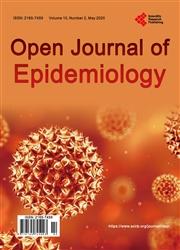Epidemiological Descriptive Analysis of Disease Outbreaks in 2019 in Sudan
引用次数: 0
Abstract
Background: Sudan has often faced outbreaks of malaria, the life-threatening waterborne disease. In 2019, the country experienced an outbreak of six different infectious diseases, i.e., cholera, chikungunya, dengue fever, diphtheria, malaria, and Rift Valley fever. Objectives: The aim of this study was to perform an epidemiological descriptive analysis of data of these disease outbreaks to determine the spatial and temporal patterns of outbreaks and to estimate the magnitude of the diseases. Methods: The data consisted of the number of cases and deaths due to disease outbreaks of cholera, chikungunya, dengue fever, diphtheria, malaria, and Rift Valley fever. We analyzed the reports of an investigation conducted by the World Health Organization and the Federal Ministry of Health, Sudan. Descriptive statistics and case fatality rate (CFR) were used in this study. Results: The frequency of disease occurrence was as follows: cholera (344 cases), chikungunya (308 cases), dengue fever (4236 cases), diphtheria (105 cases), malaria (5,188,135 cases) and River Valley fever (567 cases). The CFRs for cholera, chikungunya, are diphtheria were 4.3%, 2.05%, and 9.5%, respectively. The mortality rate of malaria was 0.0013. The states most affected by outbreaks of these diseases in Sudan were the western states. Women were at a higher risk for all diseases, except River Valley fever. Conclusions: This study highlights the patterns of the outbreak of these diseases in Sudan and provides a basis for future scientific research.苏丹2019年疫情的流行病学描述分析
背景:苏丹经常面临疟疾的爆发,这是一种危及生命的水传播疾病。2019年,该国爆发了六种不同的传染病,即霍乱、基孔肯雅病、登革热、白喉、疟疾和裂谷热。目的:本研究的目的是对这些疾病暴发的数据进行流行病学描述性分析,以确定暴发的空间和时间模式,并估计疾病的严重程度。方法:数据包括霍乱、基孔肯雅病、登革热、白喉、疟疾和裂谷热等疾病爆发造成的病例和死亡人数。我们分析了世界卫生组织和苏丹联邦卫生部进行的一项调查报告。本研究采用描述性统计和病死率(CFR)。结果:霍乱(344例)、基孔肯雅病(308例)、登革热(4236例)、白喉(105例)、疟疾(5188135例)和河谷热(567例)为发病频率。霍乱、基孔肯雅病和白喉的病死率分别为4.3%、2.05%和9.5%。疟疾死亡率为0.0013。苏丹受这些疾病爆发影响最大的州是西部各州。除河谷热外,妇女患所有疾病的风险都更高。结论:这项研究突出了这些疾病在苏丹的爆发模式,并为未来的科学研究提供了基础。
本文章由计算机程序翻译,如有差异,请以英文原文为准。
求助全文
约1分钟内获得全文
求助全文

 求助内容:
求助内容: 应助结果提醒方式:
应助结果提醒方式:


